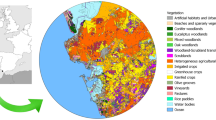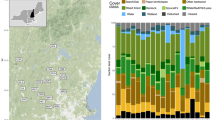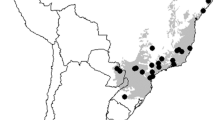Abstract
High-altitude nocturnal insect migrations are ubiquitous and represent significant pulses of biomass, which impact large areas and multiple trophic levels, yet are difficult to study and poorly understood. Predation on migratory insects by high-flying bats provides potential for investigating flows of migratory insects across a landscape. Brazilian free-tailed bats, Tadarida brasiliensis, provide valuable ecosystem services by consuming migratory pests, and research suggests migratory insects are an important resource to bats in autumn. We sequenced insect DNA from bat feces collected during the 2010–2012 autumn migrations of insects over southern Texas, and tested the utility of predator–prey interactions for monitoring migratory insect populations by asking: 1) how extensively do bats consume migratory insects during autumn? (2) does the prey community reflect known drivers of insect migrations, e.g. cold fronts? and (3) are migratory insects increasingly important to bats when local food resources decline in autumn? Bats consumed at least 21 species of migratory insects and 44 species of agricultural pests. Prey community richness increased with cold front passage. Bats consumed migratory moths over the entire autumn season, and the proportion of migratory moths in the bat diet increased over the course of the autumn season in all 3 years. This study confirms extensive consumption of migratory insects by bats, links patterns in prey communities to mechanisms driving insect migration, and documents a novel approach to tracking patterns of migratory insect movement. As an important resource for T. brasiliensis in autumn, migratory insects provide stabilizing effects to the local animal community.



Similar content being viewed by others
References
Angelo MJ, Slansky F (1984) Body building by insects—trade-offs in resource-allocation with particular reference to migratory species. Florida Entomol 67(1):22–41. https://doi.org/10.2307/3494102
Bauer S, Hoye BJ (2014) Migratory animals couple biodiversity and ecosystem functioning worldwide. Science 344(6179):1242552. https://doi.org/10.1126/science.1242552
Beerwinkle KR, Lopez JD, Schleider PG, Lingren PD (1995) Annual patterns of aerial insect densities at altitudes from 500 to 2400 meters in East-Central Texas indicated by continuously-operating vertically-oriented radar. Southwestern Entomol (Suppl 18):63–79
Betke M, Hirsh DE, Makris NC, McCracken GF, Procopio M, Hristov NI, Tang S, Bagchi A, Reichard JD, Horn JW, Crampton S, Cleveland CJ, Kunz TH (2008) Thermal imaging reveals significantly smaller Brazilian free-tailed bat colonies than previously estimated. J Mamm 89(1):18–24
Brown VA, de Torrez EB, McCracken GF (2015) Crop pests eaten by bats in organic pecan orchards. Crop Prot 67:66–71. https://doi.org/10.1016/j.cropro.2014.09.011
Burgar JM, Murray DC, Craig MD, Haile J, Houston J, Stokes V, Bunce M (2013) Who’s for dinner? High-throughput sequencing reveals bat dietary differentiation in a biodiversity hotspot where prey taxonomy is largely undescribed. Mol Ecol 23:3605–3617. https://doi.org/10.1111/mec.12531
Carlsen T, Aas AB, Lindner D, Vralstad T, Schumacher T, Kauserud H (2012) Don’t make a mista(g)ke: is tag switching an overlooked source of error in amplicon pyrosequencing studies? Fungal Ecol 5(6):747–749. https://doi.org/10.1016/j.funeco.2012.06.003
Chao A, Jost L (2015) Estimating diversity and entropy profiles via discovery rates of new species. Meth Ecol Evol 6(8):873–882. https://doi.org/10.1111/2041-210x.12349
Chao A, Gotelli NJ, Hsieh TC, Sander EL, Ma KH, Colwell RK, Ellison AM (2014) Rarefaction and extrapolation with Hill numbers: a framework for sampling and estimation in species diversity studies. Ecol Monogr 84:45–67. https://doi.org/10.1890/13-0133.1
Chao A, Ma KH, Hsieh TC, Chiu C (2016) SpadeR: species-richness prediction and diversity estimation with R, R package version 0.1.1
Chapman JW, Drake VA, Reynolds DR (2011) Recent insights from radar studies of insect flight. Ann Rev Entomol 56(1):337–356. https://doi.org/10.1146/annurev-ento-120709-144820
Chapman JW, Reynolds DR, Wilson K (2015) Long-range seasonal migration in insects: mechanisms, evolutionary drivers and ecological consequences. Ecol Lett 18(3):287–302. https://doi.org/10.1111/ele.12407
Clare EL, Barber BR, Sweeney BW, Hebert PDN, Fenton MB (2011) Eating local: influences of habitat on the diet of little brown bats (Myotis lucifugus). Mol Ecol 20:1772–1780. https://doi.org/10.1111/j.1365-294X.2011.05040.x
Cleveland CJ, Betke M, Federico P, Frank JD, Hallam TG, Horn J, Lopez JD, McCracken GF, Medellin RA, Moreno-Valdez A, Sansone CG, Westbrook JK, Kunz TH (2006) Economic value of the pest control service provided by Brazilian free-tailed bats in south-central Texas. Front Ecol Envir 5(5):238–243
Colwell RK, Chao A, Gotelli NJ, Lin S-Y, Mao CX, Chazdon RL, Longino JT (2012) Models and estimators linking individual-based and sample-based rarefaction, extrapolation and comparison of assemblages. J Plant Ecol 5(1):3–21. https://doi.org/10.1093/jpe/rtr044
Drake VA, Gatehouse AG (eds) (1995) Insect migration: Tracking resources through space and time. Cambridge University Press, Cambridge, p 478
Edgar RC (2013) UPARSE: highly accurate OTU sequences from microbial amplicon reads. Nat Methods 10(10):996–998. https://doi.org/10.1038/nmeth.2604
Edgar RC, Flyvbjerg H (2015) Error filtering, pair assembly and error correction for next-generation sequencing reads. Bioinformatics 31(21):3476–3482
Federico P, Hallam TG, McCracken GF, Purucker ST, Grant WE, Correa-Sandoval AN, Westbrook JK, Medellin RA, Cleveland CJ, Sansone CG, Lopez JD, Betke M, Moreno-Valdez A, Kunz TH (2008) Brazilian free-tailed bats as insect pest regulators in transgenic and conventional cotton crops. Ecol Appl 18(4):826–837
Fenton MB, Griffin DR (1997) High-altitude pursuit of insects by echolocating bats. J Mamm 78(1):247–250
Fitt GP (1989) The ecology of Heliothis species in relation to agroecosystems. Annu Rev Entomol 34:17–52. https://doi.org/10.1146/annurev.ento.34.1.17
Franklin MT, Ritland CE, Myers JH (2011) Genetic analysis of cabbage loopers, Trichoplusia ni (Lepidoptera: Noctuidae), a seasonal migrant in western North America. Evol Appl 4(1):89–99. https://doi.org/10.1111/j.1752-4571.2010.00135.x
Grömping U (2016) Relative importance for linear regression in R: the package relaimpo. J Stat Softw 17(1):1–27
Harrell F (2016) rms: regression modeling strategies. R package version 4.5-0. https://CRAN.R-project.org/package=rms
Hedenstrom A (2009) Optimal migration strategies in bats. J Mamm 90:1298–1309. https://doi.org/10.1644/09-mamm-s-075r2.1
Hill MO (1973) Diversity and evenness: a unifying notation and its consequences. Ecology 54:427–432. https://doi.org/10.2307/1934352
Hsieh TC, Ma KH, Chao A (2016) iNEXT: iNterpolation and EXTrapolation for species diversity. R package version 2.0.8
Hu G, Lim KS, Horvitz N, Clark SJ, Reynolds DR, Sapir N, Chapman JW (2016) Mass seasonal bioflows of high-flying insect migrants. Science 354(6319):1584
Huson DH, Auch AF, Qi J, Schuster SC (2007) MEGAN analysis of metagenomic data. Genome Res 17(3):377–386. https://doi.org/10.1101/gr.5969107
Johnson S (1995) Insect migration in North America: synoptic-scale transport in a highly seasonal environment. pp 3166. In: Drake VA, Gatehouse AG (eds) Insect Migration: tracking resources through space and time. Cambridge University Press, Cambridge
Jost L (2006) Entropy and diversity. Oikos 113:363–375
Krauel JJ, McCracken GF (2013) Recent Advances in Bat Migration Research. In: Adams RA, Pedersen SC (eds) Bat evolution, ecology, and conservation. Springer Science Press, New York, pp 293–314
Krauel JJ, Westbrook JK, McCracken GF (2015) Weather-driven dynamics in a dual-migrant system: moths and bats. J Animal Ecol 84(3):604–614. https://doi.org/10.1111/1365-2656.12327
Krüger F, Clare EL, Symondson WOC, Keišs O, Pētersons G (2014) Diet of the insectivorous bat Pipistrellus nathusii during autumn migration and summer residence. Mol Ecol 23(15):3672–3683. https://doi.org/10.1111/mec.12547
Lee YF, McCracken GF (2002) Foraging activity and food resource use of Brazilian free-tailed bats, Tadarida brasiliensis (Molossidae). Ecoscience 9(3):306–313
Lee YF, McCracken GF (2005) Dietary variation of Brazilian free-tailed bats links to migratory populations of pest insects. J Mamm 86(1):67–76
Leelapaibul W, Bumrungsri S, Pattanawiboon A (2005) Diet of wrinkle-lipped free-tailed bat (Tadarida plicata Buchannan, 1800) in central Thailand: insectivorous bats potentially act as biological pest control agents. Acta Chiropterol 7(1):111–119. https://doi.org/10.3161/1733-5329(2005)7[111:dowfbt]2.0.co;2
Lopez JD, Beerwinkle KR, Witz JA, Goodenough JL (1995) Spatial and temporal patterns of catches in pheromone traps of Helicoverpa-Zea Lepidoptera, Noctuidae and Heliothis-Virescens Lepidoptera, Noctuidae in Central Texas. Southwest Entomol (Suppl 18):5–24
Mata VA, Amorim F, Corley MFV, McCracken GF, Rebelo H, Beja P (2016) Female dietary bias towards large migratory moths in the European free-tailed bat (Tadarida teniotis). Biol Lett 12(3):20150988. https://doi.org/10.1098/rsbl.2015.0988
McCracken GF, Gillam EH, Westbrook JK, Lee YF, Jensen ML, Balsley BB (2008) Brazilian free-tailed bats (Tadarida brasiliensis: Molossidae, Chiroptera) at high altitude: links to migratory insect populations. Integr Comp Biol 48:107–118
McCracken GF, Westbrook JK, Brown VA, Eldridge M, Federico P, Kunz TH (2012) Bats track and exploit changes in insect pest populations. PLoS One. https://doi.org/10.1371/journal.pone.0043839
McNaughton SJ, Oesterheld M, Frank DA, Williams KJ (1989) Ecosystem-level patterns of primary productivity and herbivory in terrestrial habitats. Nature 341(6238):142–144. https://doi.org/10.1038/341142a0
Meyer MW, Brown RD (1985) Seasonal trends in the chemical composition of ten range plants in South Texas. J Range Manage 38(2):154–157. https://doi.org/10.2307/3899260
Morris EK et al (2014) Choosing and using diversity indices: insights for ecological applications from the German biodiversity exploratories. Ecol Evol 4:3514–3524. https://doi.org/10.1002/ece3.1155
Nagoshi RN, Fleischer S, Meagher RL (2009) Texas is the overwintering source of fall armyworm in Central Pennsylvania: implications for migration into the Northeastern United States. Environ Entomol 38(6):1546–1554
NWS (2010–2012) Weather Summary, Brownsville Texas. National Weather Service, Brownsville, TX Weather Forecast Office. http://www.srh.noaa.gov/bro/?n=2010event_annualsummary. Accessed 9 Mar 2014
Oksanen J, Blanchet F, Friendly M, Kindt R, Legendre P, McGlinn D, Minchin P, O’Hara R, Simpson G, Solymos P, Stevens M, Szoecs E, Wagner H (2016) vegan: Community Ecology Package. R package version 2.4-0. https://CRAN.R-project.org/package=vegan
O’Shea TJ (1976) Fat content in migratory Central Arizona Brazilian free-tailed bats Tadarida-Brasiliensis Molossidae. Southwest Nat 21(3):321–326
Parmesan C (2001) Coping with modern times? Insect movement and climate change. In: Woiwood IP, Reynolds DR, Thomas CD (eds) Insect movement: mechanisms and consequences. Proceedings of the Royal Entomological Society’s 20th Symposium, London, UK, September 1999. London, pp 387–413. https://doi.org/10.1079/9780851994567.0387
Ratnasingham S, Hebert PDN (2007) BOLD: the Barcode of Life Data System (www.barcodinglife.org). Mol Ecol Notes 7:355–364. https://doi.org/10.1111/j.1471-8286.2006.01678.x
R Core Team (2016) R: A language and environment for statistical computing. R Foundation for Statistical Computing, Vienna, Austria. URL https://www.R-project.org/
Showers WB, Keaster AJ, Raulston JR, Goodenough JL, Hendrix WH, Way MO, Robinson JF (1995) Seasonal migration of the black cutworm Lepidoptera, Noctuidae. Southwest Entomol (Suppl 18):119–134
Simmons JA, Fenton MB, O’Farrell MJ (1979) Echolocation and pursuit of prey by bats. Science 203(4375):16–21. https://doi.org/10.1126/science.758674
Southwood TRE, Henderson PA (2016) Ecological methods, 4th edn. Wiley, Hoboken
Valdez EW, Cryan PM (2009) Food habits of the hoary bat (Lasiurus cinereus) during spring migration through New Mexico. Southwest Nat 54:195–200. https://doi.org/10.1894/ps-45.1
Vermeire LT, Heitschmidt RK, Rinella MJ (2009) Primary productivity and precipitation-use efficiency in mixed-grass prairie: a comparison of Northern and Southern US Sites. Rangel Ecol Manag 62(3):230–239. https://doi.org/10.2111/07-140r2.1
Wheeler R, Torchiano M (2016) lmPerm: Permutation Tests for Linear Models. R package version 2.2-2. https://CRAN.R-project.org/package=lmPerm
White D, Kendall KC, Picton HD (1998) Grizzly bear feeding activity at alpine army cutworm moth aggregation sites in northwest Montana. Can J Zool 76(2):221–227
Wilkins KT (1989) Tadarida-Brasiliensis. Mamm Species 331:1–10
Zeale MRK, Butlin RK, Barker GLA, Lees DC, Jones G (2011) Taxon-specific PCR for DNA barcoding arthropod prey in bat faeces. Mol Ecol Resour 11(2):236–244. https://doi.org/10.1111/j.1755-0998.2010.02920.x
Acknowledgements
We thank J. N. Welch, D. Jones, and R. Miller for field assistance, D. Jones for lab assistance, and C. Walsh for assistance assigning haplotypes to species. We thank S. Parker and the W. Cofer, B. Gilleland, W. Gilleland, and R. King families for generous access to their property, and B. Walker, R. Zaiglin, and the students of Southwest Texas Junior College Wildlife Management Program for additional field assistance. We thank the Department of Ecology and Evolutionary Biology and the James R. Cox Professor Endowment at the University of Tennessee, and Bat Conservation International for funding. All experiments were performed under UTK-IACUC protocol no. 1947 and Texas Scientific Research Permit No. SPR-0810-119, and complied with the current laws of the country in which they were performed.
Author information
Authors and Affiliations
Contributions
JJK and GFM originally formulated the idea, JJK conducted fieldwork, JKW provided interpretation of results, VB generated sequencing data, and JJK performed molecular and statistical analyses and wrote the manuscript with assistance of VB, JKW and GFM.
Corresponding author
Ethics declarations
Conflict of interest
The authors declare that they have no conflict of interest.
Data accessibility
Data will be available from the Dryad Digital Repository upon manuscript acceptance.
Additional information
Communicated by Christian Voigt.
Electronic supplementary material
Below is the link to the electronic supplementary material.
Rights and permissions
About this article
Cite this article
Krauel, J.J., Brown, V.A., Westbrook, J.K. et al. Predator–prey interaction reveals local effects of high-altitude insect migration. Oecologia 186, 49–58 (2018). https://doi.org/10.1007/s00442-017-3995-0
Received:
Accepted:
Published:
Issue Date:
DOI: https://doi.org/10.1007/s00442-017-3995-0




